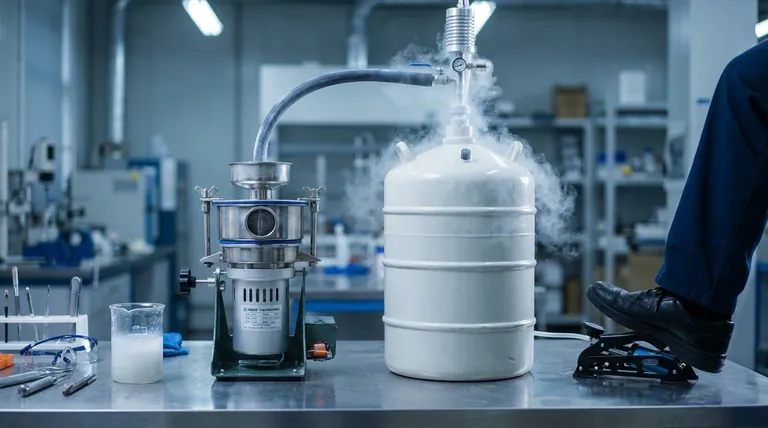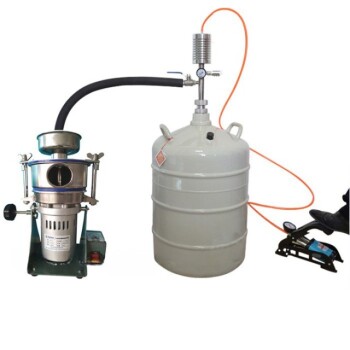At its core, cryomilling is a high-energy mechanical milling process performed at cryogenic temperatures. Instead of grinding materials at room temperature, the material is submerged in a slurry of liquid nitrogen or liquid argon. This extreme cold fundamentally changes how the material behaves during the energetic milling process, enabling the creation of unique nanostructures.
Cryomilling solves a critical problem in materials science: the intense heat generated during high-energy milling often destroys the very nanostructures being created. By using a cryogen, the process instantly quenches this heat, preserving the fine-grained structure.

The Mechanics of Cryomilling
To understand cryomilling, it is essential to first understand the principles of standard mechanical milling. This context clarifies why the addition of extreme cold is so transformative.
The Baseline: Standard Mechanical Milling
Standard high-energy milling involves placing a powder into a vial with heavy grinding balls. The vial is shaken or rotated vigorously, causing the balls to repeatedly collide with the powder particles.
This process subjects the particles to severe plastic deformation, leading to a cycle of fracturing (breaking apart) and cold welding (fusing back together). Over time, this refines the material's internal grain structure.
Introducing the Cryogen
Cryomilling adds one critical component: a cryogenic liquid, most commonly liquid nitrogen. The powder and milling media are immersed in this cryogen.
This has two immediate effects. First, it acts as an incredibly efficient coolant. Second, it creates a slurry environment that facilitates the uniform processing of the powder.
The Impact of Extreme Cold
At cryogenic temperatures (below -150°C or -238°F), most materials become significantly more brittle.
This brittleness shifts the balance of the milling process. The material is more likely to fracture upon impact rather than deform and weld. This enhanced fracture rate is key to rapidly reducing particle and grain size down to the nanoscale.
Why Cryomilling Achieves Nanostructures
The ultimate goal of cryomilling is often the synthesis of bulk nanostructured materials. The cryogenic environment is uniquely suited to achieving this by controlling the thermal and mechanical behavior of the material.
Suppressing Thermal Recovery
High-energy milling generates immense, localized heat at the point of impact. In standard milling, this heat allows the material's internal structure to "heal" or recrystallize, causing the fine grains to grow larger and destroying the desired nanostructure.
Cryomilling completely suppresses this thermal effect. The liquid nitrogen instantly absorbs the heat, preventing grain growth and locking the fine, nanometer-scale grain structure in place.
Processing Temperature-Sensitive Materials
The same principle makes cryomilling ideal for materials that cannot withstand heat. This includes many polymers, biological samples, or materials with volatile components.
The cryogenic temperature prevents thermal degradation, melting, or the loss of volatile elements during the aggressive milling process.
Understanding the Trade-offs
While powerful, cryomilling is not a universal solution. It introduces specific complexities and costs that must be considered.
Cost and Complexity
The primary trade-off is operational cost and complexity. Cryogenic liquids like liquid nitrogen are a consumable resource that must be continuously supplied.
Furthermore, the process requires specialized, insulated equipment and strict safety protocols for handling cryogenic fluids.
Material Contamination
As with any high-energy milling process, there is a risk of contamination. Tiny amounts of the milling balls or the vial wall can be abraded and incorporated into the final powder.
In cryomilling, impurities from the cryogenic liquid itself can also be a concern, requiring the use of high-purity cryogens for sensitive applications.
Making the Right Choice for Your Goal
Selecting a milling technique requires matching the process capabilities to your specific material and desired outcome.
- If your primary focus is creating bulk nanostructured metals or alloys: Cryomilling is one of the most effective techniques available for producing fine, stable grain structures at scale.
- If your primary focus is processing heat-sensitive polymers or organic samples: Cryomilling provides a way to achieve fine particle sizes without causing thermal degradation.
- If your primary focus is simple particle size reduction in a robust material: Standard mechanical milling is often a more cost-effective and straightforward choice.
Ultimately, cryomilling empowers engineers and scientists to work with materials under conditions that preserve the delicate structures that heat would otherwise destroy.
Summary Table:
| Key Aspect | Cryomilling Benefit |
|---|---|
| Temperature | Cryogenic (e.g., -196°C with liquid nitrogen) |
| Primary Effect | Enhances brittleness, suppresses thermal recovery |
| Key Outcome | Creates stable, bulk nanostructured materials |
| Ideal For | Nanostructured metals/alloys, heat-sensitive polymers |
| Main Trade-off | Higher operational cost and complexity vs. standard milling |
Ready to unlock the potential of nanostructured materials in your lab?
KINTEK specializes in providing the precise lab equipment and consumables needed for advanced processes like cryomilling. Our solutions help you achieve superior results in materials science, from creating fine-grained metals to processing delicate polymers without thermal degradation.
Contact our experts today to discuss how we can support your specific laboratory needs and help you choose the right equipment for your research goals.
Visual Guide

Related Products
- Small Cryogenic Grinder Cryomill Cryogrinder with Liquid Nitrogen for Laboratory Use
- Laboratory Ball Mill Jar Mill with Metal Alloy Grinding Jar and Balls
- Stainless Steel Laboratory Ball Mill for Dry Powder and Liquid with Ceramic Polyurethane Lining
- Laboratory Single Horizontal Jar Mill
- Laboratory Four-Body Horizontal Jar Mill
People Also Ask
- What is cryogenic grinding of herbs? Preserve Flavor and Potency with Sub-Zero Milling
- How does a grinding mill work? A Guide to Crushing, Grinding, and Pulverizing
- What is a grinder used for in a laboratory? Achieve Accurate & Homogeneous Sample Prep
- Why is crushing and grinding a sample necessary? Ensure Accurate & Reliable Material Analysis
- What is a grinder used in labs? Essential for Homogeneous Sample Preparation & Analysis



















